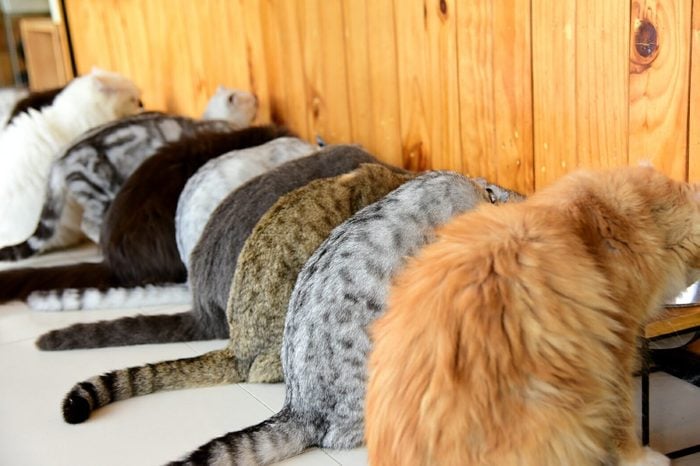
The coolest rare cat colors
Cats are intelligent and spunky creatures, forever keeping owners on their toes with their shenanigans. Along with an array of quirky cat behaviors and catlike charms, kitties also sport a variety of fur colors and patterns. Some of them are quite common, while others are considered rare cat colors.
“Cats have a combination of about three colors, which include red, white and black,” notes Grant Little, DVM, a vet expert for JustAnswer.com. “All the various combinations you see of the other colors have to do with dilutions to these colors in the gene code, as well as ways that they have been bred over time to preserve those genetic variations.”
So what are the rarest cat colors, anyway? We reached out to cat experts, who were happy to share some cat facts with us. When you’re done here, you’ll probably want to know more about cute cat breeds, fluffy cat breeds and cat body language too.
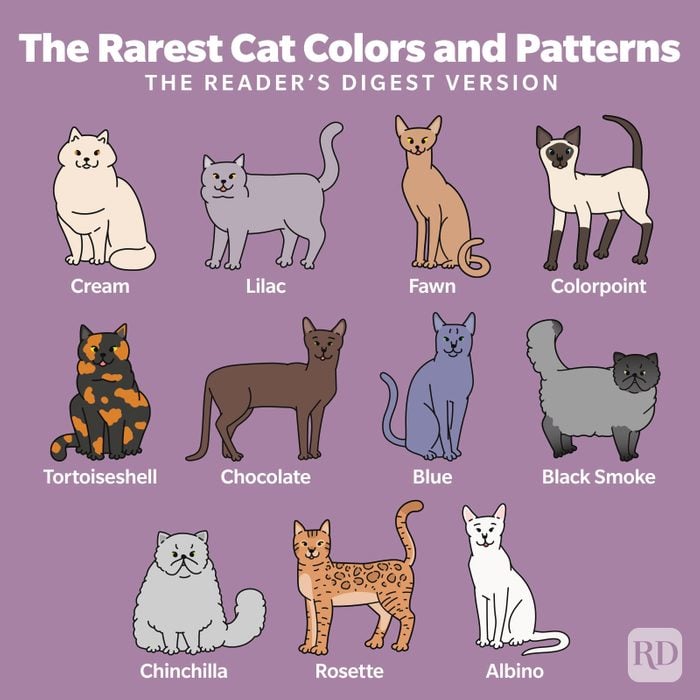
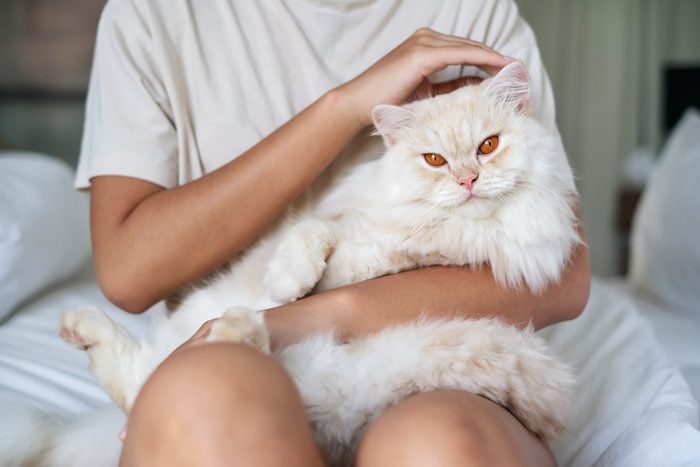
Cream
This buff hue is considered one of the rarest cat colors out there, and it’s quite beautiful with its soft white and hint of orange undertone. (In fact, cream cats are technically considered an orange cat breed.) Veterinarian Lindsay Butzer, DVM, says, “This color is derived from red or ginger coloring with the influence of a dilution gene on the distribution of yellow pigment granules.” Translation: The cream-color rules apply for any genetically red or ginger cats. A dilution gene is any gene that works to create a lighter coat color.
One reason cream-colored cats are so rare may be because breeders in England neutered cream-colored cats that were not red enough, or they sent them to the United States. “It would be extremely rare to see a cream-colored cat in a regular domestic cat breed without selectively bred breed lines mixed in,” Dr. Butzer says.
Cats breeds with this color: Persian, Ragdoll, Maine Coon, British Shorthair, Manx, Munchkin, Snowshoe
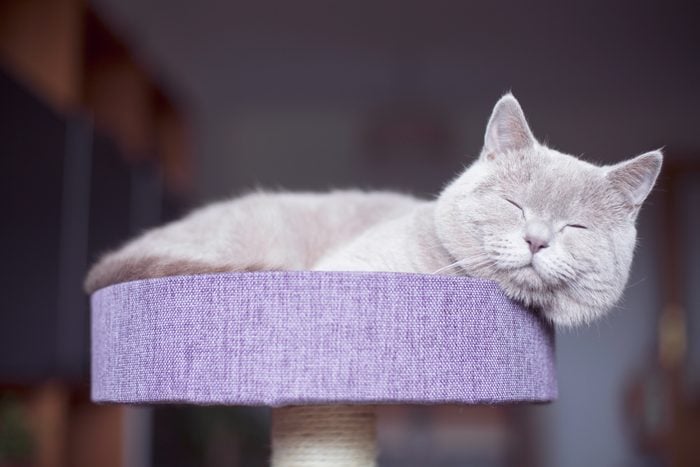
Lilac
A purple hue on a kitty? It does happen. The lilac color on a cat is actually a pale brown that is so light, it appears to have a slight purple tint. It’s not quite as purple as the name would have you believe, but it definitely has a tinge of lilac that’s quite rare for cats.
“This color is more likely found as a point-color for Persian, Siamese and Balinese breeds, and is also a solid color found in the Oriental Shorthair,” says Doron Wolffberg, founder of Cats.com. “This lilac color can only be created from both parent cats having the primary gene for coat color, called a recessive homozygote.” As a result, this color is possible only with domestic breeding.
Even if you do love the color, you may not want a layer of it on your couch and carpets, so check out these pet hair removers that really work.
Cats breeds with this color: Persian, Siamese, Balinese, Oriental Shorthair
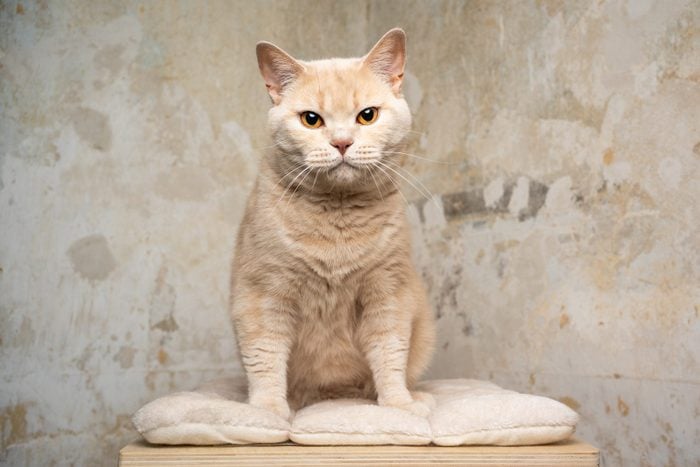
Fawn
Fawn is a rare cat color that’s similar to cream, but it’s not exactly the same. It’s considered an uncommon “diluted coat color,” which means it’s a color that’s lighter than usual. Fawn coloring is seen primarily in pedigree or purebred cats that are bred specifically for their coloration. Dr. Butzer says that fawn coloring is caused by the cinnamon genete, which is a gene that makes fur appear lighter.
“Fawn coloring is used by the Cat Fancier Association to describe light-brown coloring on the Abyssinian breed, which is from Ethiopia, and the Oriental Shorthair and British Shorthair breeds, which originated in England and parts of Asia,” she adds. Abyssinian cats, by the way, are among the smartest cat breeds.
Cats breeds with this color: Abyssinian, Oriental Shorthair, British Shorthair
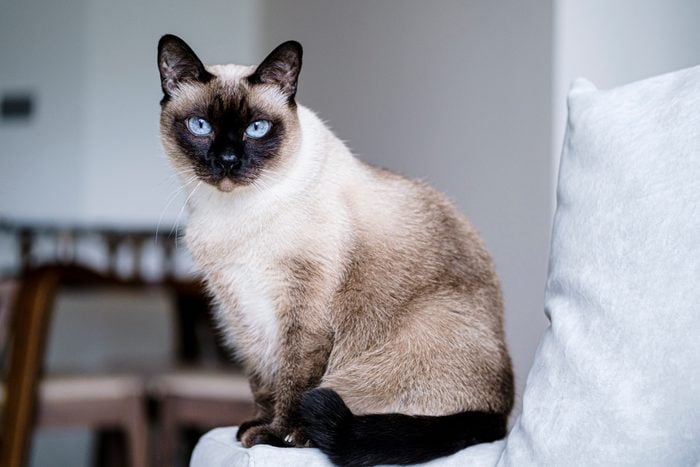
Colorpoint
Never heard of this one? Domestic cat breeding has led us to felines with “colorpoint” patterns, which is when the body of the cat is a lighter color, then it has darker coloring around the ears, paws and nose. Though more common than some colorings, it’s still considered rare for felines.
“There are 16 different point colors, including lilac, chocolate, seal and blue,” Wolffberg adds. “These are Siamese breed color variants, and many other breeds have developed from them.” Cats with this kind of fancy fur are likely to be one of the most expensive cat breeds.
Cats breeds with this pattern: Siamese, Himalayan, Birman, Ragdoll, Snowshoe
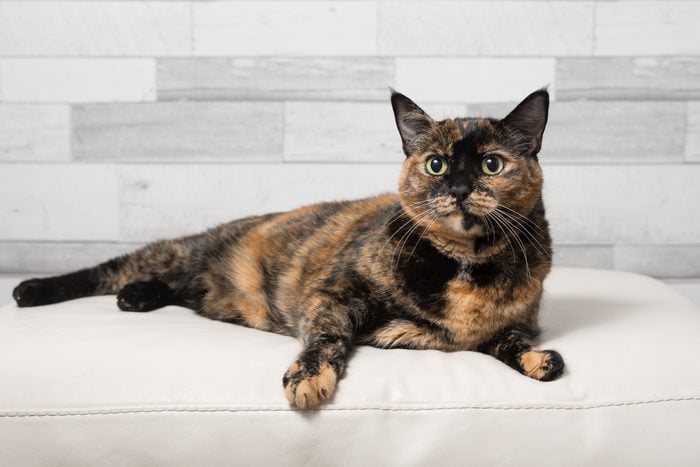
Tortoiseshell
Also known as “torties,” cats with tortoiseshell coloring have a mixture of orange and black fur. This is considered a rare cat color pattern, but there’s still a good chance you’ve seen (or owned) a few yourself.
“Tortoiseshell cats are almost always female, as the males are exceedingly rare in the wild,” notes Dr. Little. “This occurs because those colored genes are sex-linked and travel with the female X chromosome to produce that coloring distribution.”
He adds that tortoiseshell kitties are often credited with having fiery personalities. Dr. Little notes that in his practice, torties are often more resistant to handling compared with other feline patients. This doesn’t mean that your cat won’t be affectionate, though. Love, gentle handling and building trust with your cat will go a long way.
Cats breeds with this pattern: Maine Coon, Ragdoll, Persian, Cornish Rex, Ragamuffin, American Shorthair, British Shorthair
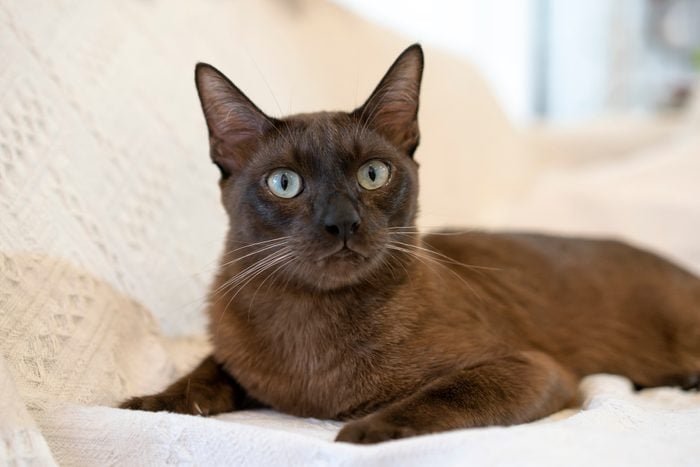
Chocolate
Not surprisingly, cocoa coloring in a cat is a combination of brown and black. But it can be so pure in its brown appearance, that it looks kinda like a small version of a chocolate Labrador retriever. And if that thought has you thinking about a new puppy, here are the dog breeds that get along best with cats.
“The coloring itself is not as rare as some of the other colorings. However, I personally have only seen two in my lifetime,” says Dr. Little. “Unless the coloring is more intentionally bred for, it can be harder to naturally occur in the wild.”
Cats breeds with this color: Havana Brown, Burmese, Balinese, Siamese, Devon Rex, Persian, York Chocolate
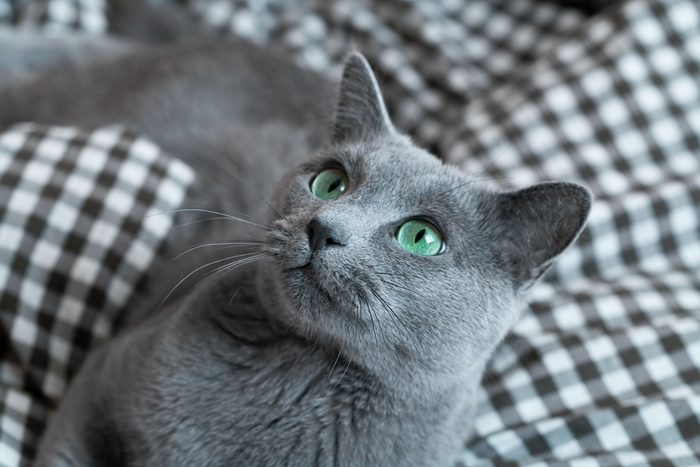
Blue
Also referred to as silver or gray, blue is a rare cat color (in real-life and in cat pictures) that’s thought to have originated in Russia. That’s one reason you’ll often see this cat coloring referred to as Russian Blue. It’s not all that common, but it’s also not as rare as some other cat colorings on this list.
“These cats can have a mixture of eye colors, from the classic yellow to a green coloring,” says Dr. Little. There are also sometimes even blue colors too. “The genes that make up the blue coloring are recessive genes, meaning both parents have to carry the genes and pass it along to their offspring for them to express the coloring.” In other words, if two blue cats are bred together, they will make a litter of very beautiful silver-looking cats.
Cats breeds with this color: Russian Blue, Korat, Chartreux, Nebelung, British Shorthair, Persian, Oriental Shorthair, Burmese, Domestic Shorthair
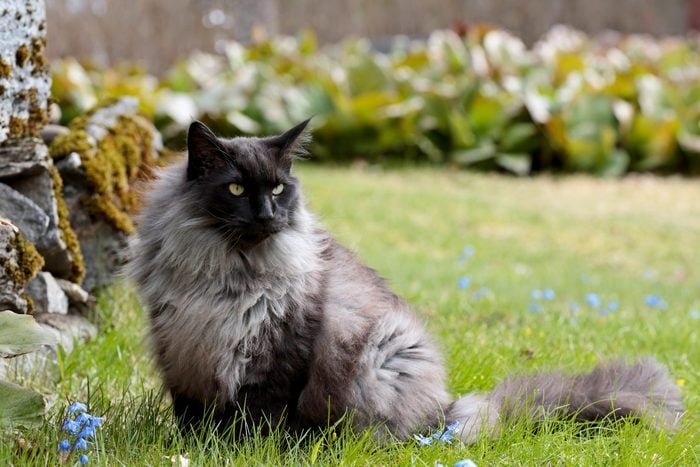
Black Smoke
Though black smoke is similar to blue/silver coloring, the two aren’t quite the same. Dr. Little explains that this rare cat color presents as a dark smokey hue, thanks to a combination of black, gray and white fur. Smoke color cats often have paws or spots that are a different color from the rest of their body—like black or white paws.
“I’ve seen this color most commonly in domestic long-hair breeds, but also in purebred Maine Coon cats,” Dr. Little says. “It is stunning in Maine Coon cats, because they have large bodies and long hair, and they look beautiful with this mixture of black, gray and white.”
Cats breeds with this color: Maine Coon, Norwegian Forest Cat, Turkish Angora, Siberian, Persian, Egyptian
Next, make sure to check out these adorable gray cat breeds you will want to snuggle ASAP.
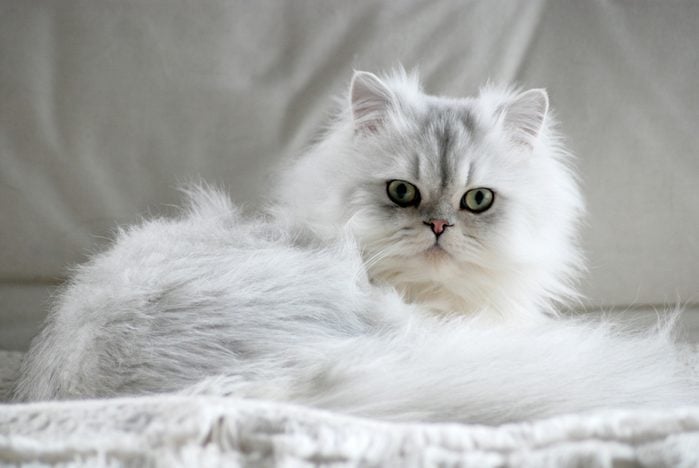
Chinchilla
Chinchilla-colored cats have long, luxurious hair and large round eyes like Persian cats. Their genes create a faded look at the base of the hair. “The actual hair coat of these cats are white at the roots, and the tips of each hair will be the cat’s primary colors, such as tabby, blue, black, red, cream, chocolate and so on.”
Dr. Butzer adds that if a cat is shaded silver, then the amount of pigmentation falls between the smoke and chinchilla shades. Chinchilla cats often have a chunky body and large paws.
Cats breeds with this color: Persian, Maine Coon
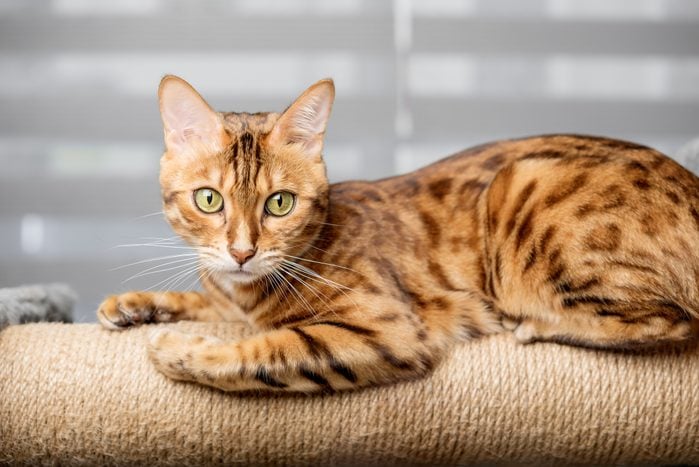
Rosette
The rosette pattern is a fusion of brown, black and white that look like swirling-rose spots. It’s a very rare cat pattern for domestic cats, one you’ve likely only seen on big wild cats like leopards. Cats with rosette color patterns are so special, they are one of the most commonly stolen cat breeds.
Wolffberg tells us that the rosette pattern on cats is determined by what’s called the agouti gene, which is related to tabby patterns. “The tabby stripe pattern occurs naturally and resembles the coats of wildcats, but the rosette pattern is found in very few domestic cat breeds,” says Wolffberg.
Cats breeds with this pattern: Bengal, Serengeti, Savannah, Ocicat, Egyptian Mau, Maine Coon
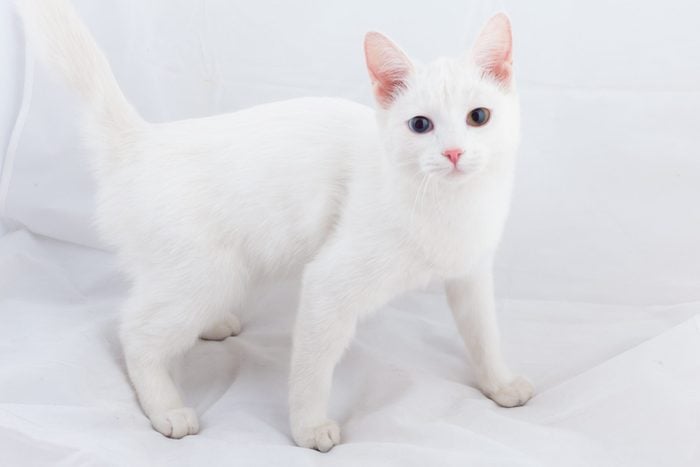
Albino
We’ll finish out our list of rare cat colors with the rarest of them all: albino. This is when there’s no coloring at all, and it impacts not just a cat’s fur, but also its eyes and skin. “Unlike a cat with just the white fur gene, both parent cats must have recessive albino genes and the offspring must receive both,” explains Wolffberg.
Long story short, the recessive gene in albino cats causes them to produce no melanin in their skin. This creates white fur and pink hues on body parts with less hair such as ears, nose and paws. Their eyes can also be red or very pale blue or green.
Unfortunately, albino cats are prone to some health issues. Wolffberg says this recessive gene impairs their ability to produce melanin, so they’re more prone to eye and skin illnesses.
Cats breeds with this color: Albinism can occur in any cat breed
Sources:
- Grant Little, DVM, a vet expert for JustAnswer.com
- Lindsay Butzer, DVM, a veterinarian at Clint Moore Animal Hospital in Boca Raton, Florida
- Doron Wolffberg, founder of Cats.com
